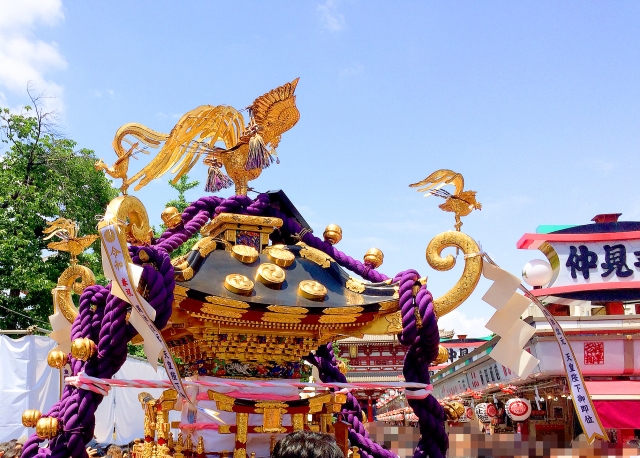行事 / EVENT
『浅草三社祭り』見物と『くみ踊り』鑑賞
"Asakusa Sanja" Festival & "Kumi-Odori" (Geisha Dance)

春本番が近づいて参りました。日加協会、春の行事として、本年は、江戸の大祭「浅草三社祭り」見学と浅草芸者が永い歴史と伝統で培ってきた三社祭りの華、「くみ踊り」の鑑賞を企画致しました。
雷門から仲見世通り、浅草神社へと続く、勇壮な神輿渡御を見物し、見送った後、浅草芸者衆の稽古場である「見番」のお二階に上がって、花柳流、藤間流、幇間の三組で構成される伝統的な日本舞踊「くみ踊り」をお弁当を頂きながら、ゆっくり鑑賞致します。(座布団席及び椅子席もご用意あり)
見番の定員人数により、今回のイベントは、先着15名様までの限定とさせていただきます。ご参加を希望される方は、お早めにお申し込みください。
As a spring event of the Canada-Japan Society, we are pleased to provide members and guests with an opportunity to see the Asakusa Sanja Matsuri, Tokyo’s largest Shinto festival, followed by lunch watching a Japanese dance show, the Sanja Matsuri’s highlight featuring traditional and time-honored Asakusa geisha dance performances. This event is scheduled for May 15, 2016, the final day of the three-day festival.
You will first see the dynamic and exciting procession of the three main mikoshi (portable shrines) of Asakusa Shrine going from the Kaminarimon Gate down Nakamise-dori toward Asakusa Shrine, After seeing the parade, you will proceed to the second floor of the Asakusa Kenban (where geisha are trained) to watch a traditional Japanese dance show called “Kumi Odori” comprising performances by three groups of dancers (Hanayagi-ryu, Fujima-ryu, and Hokan (professional male entertainers)), while at the same time enjoying a bento (box) lunch sitting on zabuton floor cushions or chairs which are also available.
Due to limited seating space, participation is limited to 15 persons, with registrations to be accepted on a first-come, first-served basis. Early registration is highly recommended.
Schedule
| 11:00 | 浅草文化観光センター 1階ロビー 銀座線浅草駅徒歩1分 雷門真ん前 |
Meet at the Asakusa Culture Tourist Information Center (Asakusa Bunka Kanko Center) Lobby on the ground floor The Center is located right in front of the Kaminarimon Gate, one minute walk from Asakusa Station on the Tokyo Metro Ginza Line. |
|---|---|---|
| 11:00~ | 三茶祭り神輿行列見物 | View the Sanja Matsuri mikoshi (portable shrines) parade |
| 12:30~ | 浅草見番到着 | Arrive at Asakusa Kenban |
| 13:00~14:30頃 | 「くみ踊り」(花柳流・藤間流・幇間の三組による日本舞踊)鑑賞 お弁当・お飲み物付 |
Watch the Kumi Odori Show presenting traditional Japanese dance performances by three groups: Hanayagi-ryu dancers, Fujima-ryu dancers, and Hokan (male entertainers) Bento lunch and drinks to be served. |
「浅草三社祭のいわれ」
浅草寺縁起によると、今から1390年程の昔、隅田川で漁労に精を出していた檜前浜成・竹成の二兄弟が漁網の中から一像を持ち帰り、土地の文化人である土師眞仲知(はじのまつち)に一見を請うた処、土師は、これは尊い聖観音像であり、自分も帰依する所の深い仏像であると、二人の者にその功徳を諄々と説き、自邸に堂舎を構えて寺とし、三人共々厚く聖観音像をお祀りする様になったと言う。
これが、浅草寺の起源であり、後世、この三人が浅草の開拓者として、三社大権現の尊称を奉られ祭詞される様になった。 それは、権現思想(仏が神の姿を借りて現れる神仏同体説)の流行しだした平安末期(約800年前)だろうと言われる。
その後、明治6年三社権現社の名称は廃され、現在は、浅草神社と呼ばれている。その大祭の神輿渡御は、江戸第一の荒祭りとして浅草人の血を湧かせ、その賑わいは府外随一として全国に喧伝された。
又、現在の社殿は、徳川三代将軍・家光が慶安二年(1649)に建立寄進した。江戸初期の代表的権現造り建築で、幾多の災厄を逃れ、国の重要文化財に指定され、昭和38年と平成8年に多額の国費の補助を受け、創建当時の姿に修復された。
History of Asakusa Sanja Matsuri
According to the legend of Sensoji Temple, some 1390 years ago, two fishermen brothers named Hinokuma Hamanari and Hinokuma Takenari found a statue caught in their fishing net in the Sumida River and took it home. When they showed it to a local man of culture named Haji-no-Matsuchi, he told them that it was a statue of Sho Kannon (a Buddhist deity) and that he was a devout believer in this deity. He earnestly preached to the two brothers on the meritorious deeds performed by Kannon. He remade his house into a temple to house and honor the statue, and all the three men deeply worshipped it.
That was the origin of Sensoji Temple. Years later, as developers of Asakusa, the three men were given the honorific title of Sanja Dai Gongen(Gongen is a title in Shinto) and enshrined there. It is said that this took place towards the end of the Heian period (some 800 years ago) when the Gongen idea for Shinto-Buddhism syncretism based on the notion that Kami (Shinto deities) were manifestations of Buddhas was becoming popular.
The name of the shrine where the three men were enshrined was Sanja Gongenja, but in 1873 this name was abolished and the shrine is now called Asakusa Shrine. The parade of the mikoshi (portable shrines) of this shrine in the Sanja Matsuri thrilled and energized the people of Asakusa as the wildest event in Edo, and the liveliness of the festival was touted as unparalleled all over Japan.
The present main building of the shrine was constructed and donated in 1649 by Iemitsu Tokugawa, the third shogun. It is a structure built in the Gongen style, an architectural style typical of the early Edo period, and has survived many disasters. Designated as an Important Cultural Asset by the government, the shrine was repaired and restored to its original shape in 1963 and in 1996 with large financial assistance from the government.
Event Details
平成28年5月15日(日)
May 15, 2016 (Sun)
Registration closed
11:00 集合 /
浅草文化観光センター 集合
(台東区雷門2-18-9 Tel 03-3842-5566)
Meet at the Asakusa Culture Tourist Information Center
(2-18-9 Kaminarimon, Taito-ku, Tel: 03-3842-5566)
\5,500(会員 / Members)
\6,000(ゲスト / Guest)
くみ踊り鑑賞、お弁当、飲み物を含む / includes dance show, bento lunch and drinks
お食事は様々な食材が盛り込まれた松花堂弁当とカフェ(珈琲等)をお楽しみいただきます

